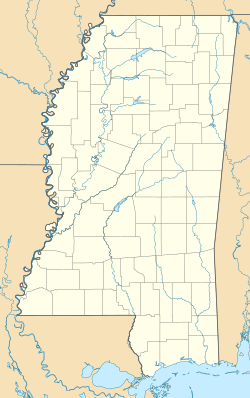Baxterville, Mississippi facts for kids
Quick facts for kids
Baxterville, Mississippi
|
|
|---|---|
| Country | United States |
| State | Mississippi |
| County | Lamar |
| Area | |
| • Total | 3.15 sq mi (8.2 km2) |
| • Land | 3.15 sq mi (8.2 km2) |
| • Water | 0.006 sq mi (0.02 km2) |
| Elevation | 407 ft (124 m) |
| Population
(2020)
|
|
| • Total | 267 |
| • Density | 84.7/sq mi (32.7/km2) |
| Time zone | UTC-6 (Central (CST)) |
| • Summer (DST) | UTC-5 (CDT) |
| Area code(s) | 601 |
| GNIS feature ID | 666577 |
| FIPS code | 28-03940 |
Baxterville is a small community in Lamar County, Mississippi. It is known as a census-designated place, which means it's an area the government counts for population, but it doesn't have its own city government. Baxterville is located in the southwestern part of Lamar County, along Mississippi Highway 13. It is southwest of the city of Hattiesburg.
The community has one school, Baxterville School. This school is part of the Lamar County School District. It teaches students from kindergarten all the way through eighth grade. Baxterville is also home to several churches and cemeteries.
A fun place nearby is Little Black Creek Water Park. You can find it off the Purvis-Baxterville Road. The park offers many activities like camping, picnic spots, swimming, and fishing. There is also a nature trail to explore. The park is open from Wednesday to Sunday. It is part of the Pat Harrison Waterway District. You can also get to the park from Interstate 59 through Lumberton, MS.
According to the 2020 Census, Baxterville had a population of 267 people.
History of Baxterville
Baxterville was once a stop on the Gulf and Ship Island Railroad. Back in 1906, about 150 people lived here. At that time, the community had a turpentine still. This was a place where they made turpentine from pine trees. There were also two sawmills, which cut logs into lumber.
Underground Tests at Tatum Salt Dome
Something very unusual happened near Baxterville. On October 22, 1964, at 10:00 a.m., the United States Atomic Energy Commission set off a special bomb. This bomb was exploded deep underground. It was inside the Tatum Salt Dome, which is a huge natural salt formation. This event was part of something called Project Salmon.
The plan was to detonate a single nuclear bomb. It was placed about 2,700 feet deep inside the solid salt. Two miles from where the bomb went off, the ground shook so much that pecans fell from trees. Homes, barns, and other buildings close to the test site had serious damage. About 400 people living nearby had to leave their homes for the day.
At the test site, creeks turned black with muddy water. Seven days after the explosion, more than 400 local residents had reported damage. They said their homes were harmed or their water wells had dried up.
Project Salmon was seen as a success. The bomb had the same power as 5,000 tons of TNT. This was about one-third as powerful as the bomb that destroyed Hiroshima in 1945. People felt the shock wave in downtown Hattiesburg, which is almost 30 miles away.
The bomb created a round, hollow space about 110 feet wide inside the salt dome. This new underground cavern was used for a second nuclear test. This second test, called Project Sterling, happened on December 3, 1966. It had the power of 350 tons of TNT. These two underground nuclear explosions were the only ones ever done in the U.S. east of the Rocky Mountains.
The Tatum Salt Dome site had two more tests later. These were part of Project Miracle Play. Like Project Dribble, this project was designed to detect underground explosions. But these two blasts used regular bombs, not nuclear ones. Mississippi's two Project Miracle Play explosions happened in 1969 and 1970. They were powered by a mix of oxygen and methane gas.
Population Information
| Historical population | |||
|---|---|---|---|
| Census | Pop. | %± | |
| 2020 | 267 | — | |
| U.S. Decennial Census 2020 |
|||
In 2020, the population of Baxterville was 267 people.



